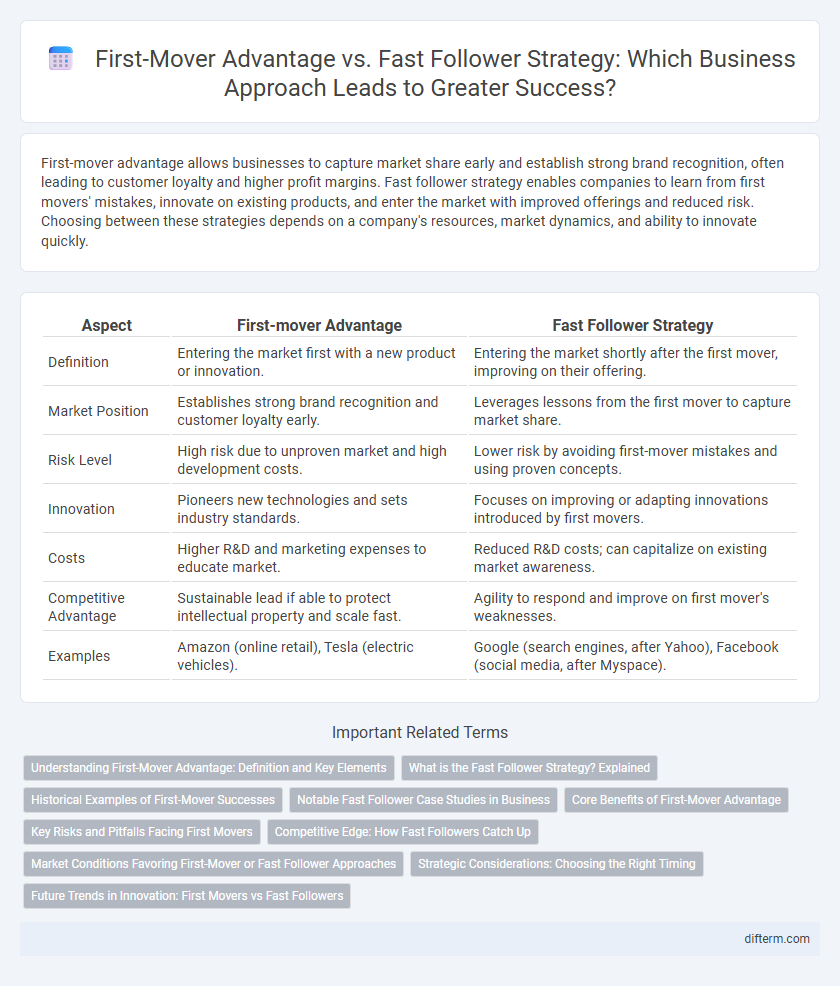First-mover advantage allows businesses to capture market share early and establish strong brand recognition, often leading to customer loyalty and higher profit margins. Fast follower strategy enables companies to learn from first movers' mistakes, innovate on existing products, and enter the market with improved offerings and reduced risk. Choosing between these strategies depends on a company's resources, market dynamics, and ability to innovate quickly.
Table of Comparison
| Aspect | First-mover Advantage | Fast Follower Strategy |
|---|---|---|
| Definition | Entering the market first with a new product or innovation. | Entering the market shortly after the first mover, improving on their offering. |
| Market Position | Establishes strong brand recognition and customer loyalty early. | Leverages lessons from the first mover to capture market share. |
| Risk Level | High risk due to unproven market and high development costs. | Lower risk by avoiding first-mover mistakes and using proven concepts. |
| Innovation | Pioneers new technologies and sets industry standards. | Focuses on improving or adapting innovations introduced by first movers. |
| Costs | Higher R&D and marketing expenses to educate market. | Reduced R&D costs; can capitalize on existing market awareness. |
| Competitive Advantage | Sustainable lead if able to protect intellectual property and scale fast. | Agility to respond and improve on first mover's weaknesses. |
| Examples | Amazon (online retail), Tesla (electric vehicles). | Google (search engines, after Yahoo), Facebook (social media, after Myspace). |
Understanding First-Mover Advantage: Definition and Key Elements
First-mover advantage refers to the competitive edge gained by a company that pioneers a new product, market, or technology, allowing it to establish strong brand recognition and customer loyalty before competitors enter the space. Key elements include innovation leadership, control over resources or distribution channels, and the ability to set industry standards that create high entry barriers for followers. This strategic position often leads to higher profit margins and market share in the early stages of market development.
What is the Fast Follower Strategy? Explained
The Fast Follower Strategy involves entering the market shortly after a first mover has introduced a new product or service, leveraging their initial market research and customer education efforts. This approach allows businesses to minimize risks associated with innovation while improving on the first mover's shortcomings, often benefiting from lower development costs and refined strategies. Companies employing the fast follower strategy capitalize on market insights and consumer feedback to gain competitive advantages without bearing the full burden of pioneering.
Historical Examples of First-Mover Successes
Amazon exemplifies first-mover advantage by dominating e-commerce early, establishing brand recognition and customer loyalty that competitors struggled to surpass. Similarly, Coca-Cola capitalized on being the first major soft drink brand, leveraging extensive distribution and marketing to maintain market leadership. These historical examples demonstrate how pioneering products or services can secure long-term competitive benefits through innovation and market control.
Notable Fast Follower Case Studies in Business
Notable fast follower case studies in business highlight how companies like Facebook capitalized on the groundwork laid by MySpace, refining the social networking model to achieve greater market dominance. Another example includes Google, which improved upon early search engines like Yahoo and AltaVista by offering more accurate and faster search results, securing its position as the industry leader. Fast followers benefit by avoiding initial market risks while leveraging insights to enhance products and capture significant market share.
Core Benefits of First-Mover Advantage
First-mover advantage provides businesses with the ability to establish strong brand recognition and customer loyalty before competitors enter the market. Securing critical resources and setting industry standards further strengthens market position. Early entry often leads to higher profit margins due to reduced competition and the ability to influence consumer preferences.
Key Risks and Pitfalls Facing First Movers
First movers face significant risks including high research and development costs, market uncertainty, and the challenge of educating consumers about new products. They may also encounter issues with immature technologies and infrastructure, which can lead to operational inefficiencies. Fast followers can capitalize on these pitfalls by improving products, reducing costs, and leveraging established market knowledge.
Competitive Edge: How Fast Followers Catch Up
Fast follower strategy leverages the pioneering efforts of first movers by analyzing market responses and improving product offerings, which reduces innovation risks and development costs. Fast followers benefit from established market awareness and customer feedback, enabling them to refine features and implement efficient marketing tactics to capture significant market share. This approach accelerates competitive edge by combining timely entry with optimized resources and strategic positioning.
Market Conditions Favoring First-Mover or Fast Follower Approaches
Markets with high technological uncertainty and rapidly changing customer preferences favor fast followers who can adapt products quickly based on early market feedback. First-mover advantage excels in markets where strong brand loyalty, high entry barriers, and significant economies of scale protect early entrants from competition. In contrast, fast follower strategy thrives in dynamic markets where imitation costs are low, enabling rapid iteration and improved solutions that capture market share from pioneers.
Strategic Considerations: Choosing the Right Timing
Selecting the optimal timing between first-mover advantage and fast follower strategy hinges on market readiness, technological feasibility, and resource allocation. First movers gain brand loyalty and establish high switching costs, while fast followers capitalize on improved products and reduced R&D risks. Strategic decisions must evaluate competitive dynamics, consumer adoption rates, and innovation cycles to maximize market penetration and sustainable growth.
Future Trends in Innovation: First Movers vs Fast Followers
Future trends in innovation indicate a growing emphasis on agile adaptation, where fast followers leverage real-time market data and emerging technologies to refine and scale innovations rapidly. First movers benefit from establishing brand recognition and setting industry standards but face higher risks and costs associated with unproven markets and technologies. Fast followers capitalize on reduced uncertainty and improved product-market fit, often employing strategic partnerships and data analytics to accelerate growth and capture market share efficiently.
First-mover Advantage vs Fast Follower Strategy Infographic

 difterm.com
difterm.com